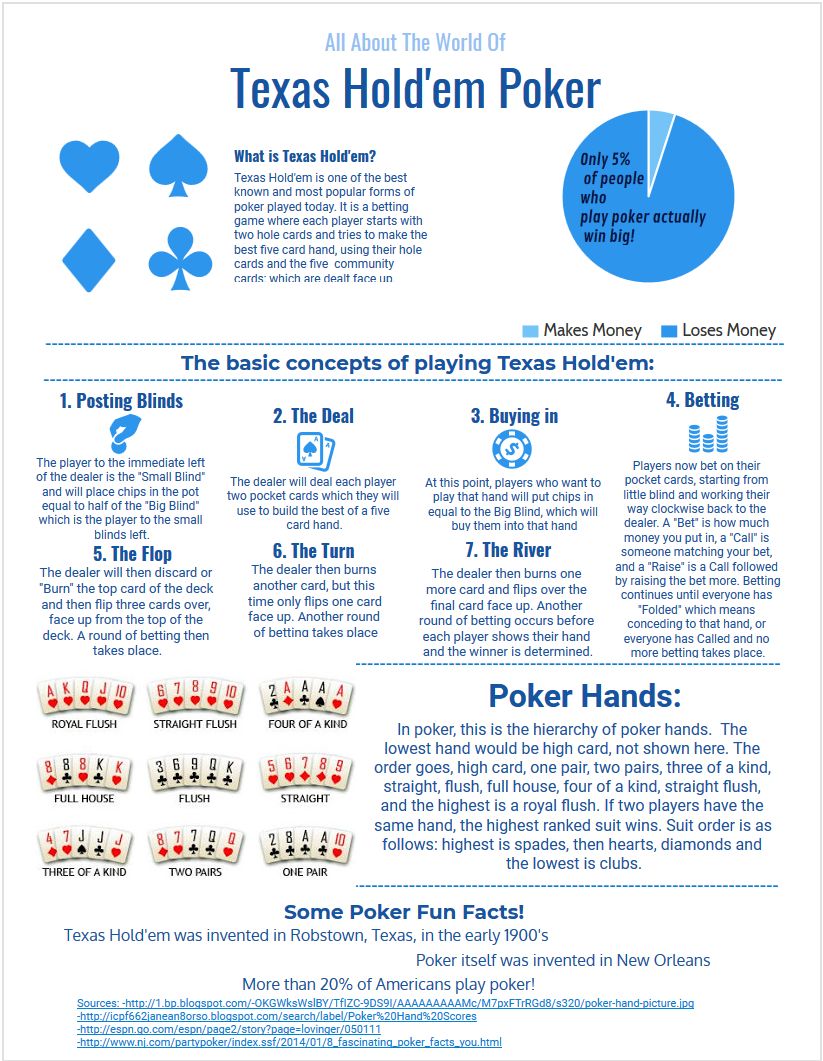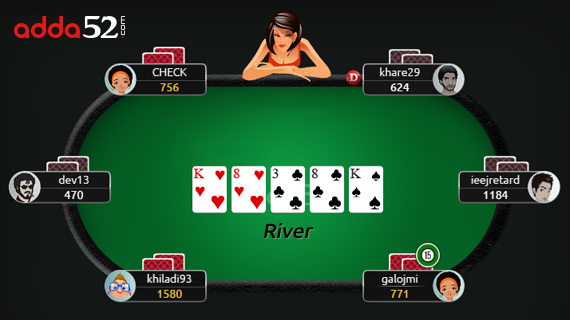Texas Holdem Button Rules
Posted : admin On 7/28/2022
Texas hold'em is played by a rotating dealer and the player on button receives last action on all post-flop streets of play. Once the hand completes, the player with the dealer button will pass it to the player left to him or her. The Blinds (blind Bets) There are two blinds in Holdem: a small blind and a big blind. Aug 19, 2019 Card Game Rules Texas Hold’em Poker is a casino type game where the objective is to win the best hand out of a group of players. Players are initially given two cards, called “hole” cards, that they hold throughout the game (hence the name). They then try to make the best five card hand out of their initial holes and five community cards. When playing Texas hold ‘em a round flat chip or “disk” is used to represent the position of the dealer. This disk is placed in front of the dealer to indicate their status. The person sitting to dealer left is known as the small blind and the person sitting to the left of the small blind is known as the big blind. The deal moves in a clockwise direction. Once a hand is completed the deal always passes to the player to the dealer's left. A small white disc, known as a button, is used to indicate the dealer for the current hand. The player who is dealing the hand is known as the button and the two players to his left are known as the blinds. Dec 11, 2020 The second most popular form of Texas Hold'em is Limit Holdem.Whereas No-Limit is a game of brute force where players play big stacks and run up huge bluffs, Fixed Limit Hold'em is a more subtle, gentleman's game where players look to exploit small edges: a game of finesse and well-timed aggression.
Let's have a quick recap of the fundamental rules of the Texas Holdem poker game. First, there are the forced bets like antes and blinds. Then there is the play of hands where players get to know the pre-flop, the flop, the turn, and the river. Each of these has betting rounds where the players can call, raise, check or fold. Next in line is the showdown where the winner will be determined.
Once poker players get to know all these different basic and fundamental rules in Texas Holdem poker, it is but right for them to understand the more advanced aspects of the game. These complications usually happen in isolated cases that are uncontrollable. With the help of these rules, the game would be in order, under control, and free from any irregularity all the time.
The more advanced rules in Texas Holdem poker include the simplified moving button rule as well as the dead button rule. In cases wherein players in the blinds leave the game, these are the most known rules that are put into effect. The simplified moving button rule is most of the time used in online Texas Holdem poker cash games. On the other hand, actual Texas Holdem poker cash games use the dead button rule in such cases.
In the simplified button rule, the button will also go to the next player available in the rotation once the player with the button leaves. The small blinds as well as the big blinds will then follow. As always, the small and big blinds can be found at the left side of the dealer button. But in this case, the dealer button will never be missed. There is at least a single player from all those remaining which will have the dealer button. On the other hand, the blinds may be missed if the seats next to the dealer button are empty.
By knowing this rule, the poker table would still be orderly even after some players have exited from the game for whatever reasons they might be. That's what rules are for after all, aren't they. Order is very important in cash games such as Texas Holdem poker. Another important rule to know in this game is the dead button rule.
Just like the simplified button rule, the dead button rule is also used to give proper order after some players have moved out of the game. However, this rule is more often used in actual Texas Holdem games that involve cash. The rule basically goes like this. The big blind bet will be assigned to the one who is about to put it. The dealer button as well as the small blind bet may be situated in vacant seats. There would only be a single big blind bet for each hand. When the small blind bet lands on an empty seat, the small blind bet would be nullified for that hand.
One of the more confusing aspects of Texas Hold’em for beginners is how betting works during the game. Depending on the structure of the game you’re playing in, the rules for betting can be very different, and sometimes rather confusing. Here’s a quick guide to Texas Hold’em Betting that should help you understand exactly what’s going on.
Texas Hold’em Betting: General Rules
In Texas Hold’em, betting begins to the left of the dealer button and moves around the table clockwise. At the beginning of a hand, two players must make forced bets, called blinds, in the two seats directly to the left of the button. At any time, players have the option to call the current bet, raise the current bet, or fold their hand. If no bets have been made yet in a round, players also have the option of passing their turn by checking.
Each Texas Hold’em betting structure also has its own betting rules.
Texas Hold’em Betting: Limit Texas Hold’em
In Limit Texas Hold’em, betting is structured so that all bets on a given round are of the same size. In the vast majority of cases, a smaller bet is required in the first two rounds of betting, with a larger bet required on the turn and river.
Generally, a Limit Texas Hold’em game will be named based on the size of these bets. For instance, a $2/$4 Limit Texas Hold’em game will have $2 bets and raises early in the hand, and $4 bets and raises later in the hand. The large blind is usually the size of the smaller bet (in this case, $2), and the small blind will be about half the size of the large blind (again, in this case, $1).
Texas Hold’em Betting: No Limit Texas Hold’em


In No Limit Texas Hold’em, betting limits are mostly eliminated. When players bet or raise, they now have the option of betting as much of the money they have in front of them as they like. The only restriction is that any bet must be at least the size of the big blind, and any raise must be at least as large as the raise that proceeded it.
Most No Limit Texas Hold’em games will be named after the size of the blinds being used. A $1/$2 No Limit game will have a $2 big blind, and a $1 small blind. Each bet will need to be at least $2. If a player raises that bet to $6, that is a raise of $4; if another player wishes to raise again, they will need to make the bet at least $10 ($6 plus the $4 size of the previous raise).
Texas Hold’em Betting: Pot Limit Texas Hold’em
Pot Limit Texas Hold’em betting is slightly more complex than in the above examples. While players may raise more than they can in Limit games, they do not have complete freedom as in No Limit games. Instead, players are limited by raising the amount of the current pot size.
Calculating the pot size for these games can sometimes seem complicated. The pot is considered to be the total of the chips already in the pot on previous rounds, bets made on the current round of betting, and the amount the current player would need to call before making a raise.
For instance, imagine a pot that already has $50 in it. A player then opens the betting on a new round with a $20 bet. If the next player wishes to raise, the pot size is:
$50 for the previous rounds’ bets
$20 for the current round’s bet
$20 for what the next player would have to call to stay in the hand.
This means that the current pot is considered $90, and the player may raise an additional $90 beyond that. Thus, the player may put up to $110 into the pot — $20 to call, and another $90 to raise.
As with No Limit Hold’em games, the games are usually named based on the size of the blinds; a $1/$2 Pot Limit Hold’em game will have a small blind of $1 and a large blind of $2.
Texas Hold’em Betting: Spread Limit Texas Hold’em
While it’s a less common variant, you may sometimes find Spread Limit Texas Hold’em games available. These games allow players to bet or raise anywhere in a given range of allowable bets. For instance, a $1-$5 Spread Limit Texas Hold’em game would allow bets anywhere from $1 to $5. As with other games, normal betting rules still exist; specifically, a raise must be at least the size of the previous bet or raise (in other words, if one player raises $5, the next cannot raise $1).

Texas Holdem Betting Strategy
Betting is the crux of poker. The game of Texas Hold’em consists of a series of bets based on the perceived strength of your cards – without betting, it would simply be a game of who got dealt the best hand and players would just wait to have the best possible hand before wagering money.
Many players totally misunderstand the art of betting – too often on forums, I’ve heard players say they bet “to see where I’m at” or “because he checked”. Let’s be clear: your bet should be one of two things; a value bet or a bluff.
Value Bet
A value bet is, quite simply, betting your hand for value. This means you believe your opponent will call with a worse hand. When you raise AK before the flop, it’s a value bet. If you bet 88 on a 824 board, it’s a value bet. It’s quite simple – if you think that your opponent’s range of hands is worse than your holding, bet for value and hope for a call.
Bluff
A bluff is the opposite of a value bet – you think your opponent’s range of hands is stronger than your hand, however you don’t think it is strong enough to call a bet. So, you bet.

If, for example, you have Ah-Qh on a low board with two hearts, you have a strong hand and bet for value. The turn and river blank and your opponent checks to you. If you think he has a middle pair that won’t call a third bet, bet and take down the pot.
Semi-Bluff
A semi-bluff is a bet that right now is likely to be behind your opponents range, but has the chance to improve on later streets. The 2 most common types of semi bluffs are with large draws such as a flush draw that has 9 outs and an open ended straight draw that has 8 outs (learn how to count outs here).
Take the example above of having Ah-Qh on a board of 9h-4h-2c. You have only ace high but your nut flush draw and two overcards give you a good chance to win the pot – in fact, against JJ on that board you are a 55/45 favourite!
Therefore a semi-bluff is a bet made as a bluff, such as with ace high and a flush draw, that aims to fold out a better hand but has numerous outs if called. This way even if a better hand does call your bluff, you can still take the pot with a good turn or river card.
Texas Holdem Button Rules Card Game
When to Value Bet; When to Bluff?
This question simply boils down to how to read your opponents’ hand. A detailed article on this would far exceed a reasonable word count, so I’ll attempt to surmise succinctly as I have done in the previous beginner articles.
Firstly, you don’t put your opponent on a hand – you put him on a range of hands. If someone raises before the flop then bets the flop and turn of a 9-8-2 board they don’t automatically have KK or 22 or 98. To narrow down an opponent’s range, let’s use an example hand. A decent, tight-aggressive player raises under the gun. You call on the button; your cards are irrelevant but say you have 77. Both blinds fold. Now, before the flop is dealt, ask what is his range? Knowing what you know about this player (that’s he’s a pretty good TAG) you can confidently give him an estimated range of AA-22 and AK-AJ.
The flop is something unconnected and dry, such as 9c-5d-2d. Your opponent bets and you call, knowing he will continuation bet his entire range. The turn is the 5c and your opponent bets again – now his range has narrowed.
Texas Holdem Button Rules Poker
He is unlikely to have 99, 55 or 22 as many players will check this hand and allow you to bluff off your chips into their monster.
He also probably doesn’t have any pair less than 99, nor is he likely to have AK-AJ unless he holds the nut flush draw. His range therefore has narrowed to TT+, AdKd, AdQd and AdJd.
This is a very simple example about how you can narrow down someone’s range of hands over a few rounds of betting.